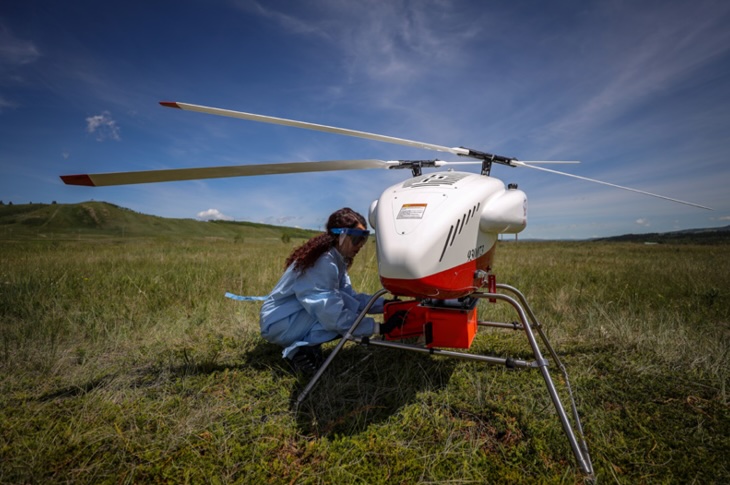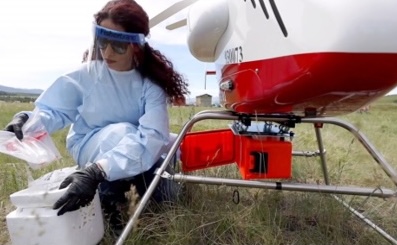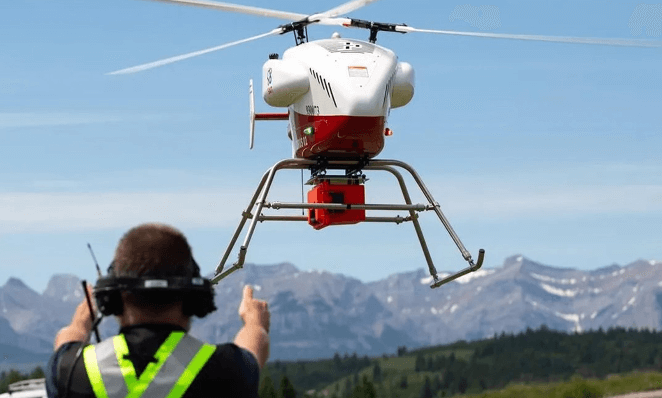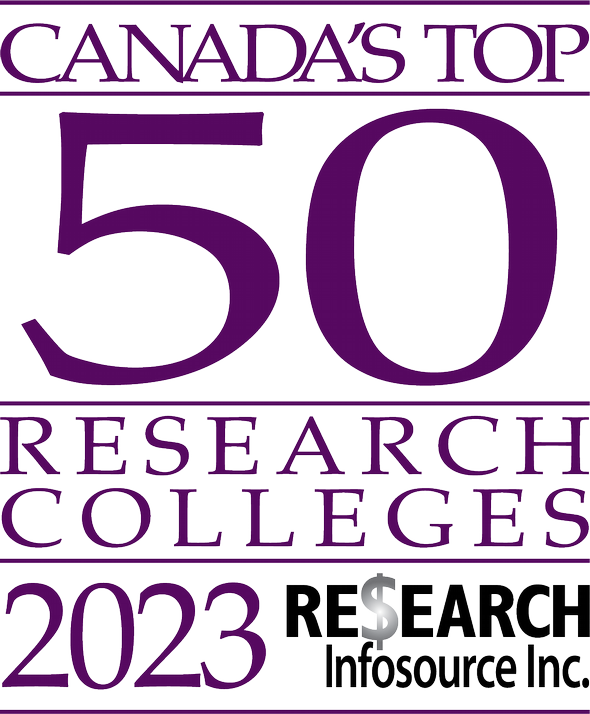Medical Delivery using Drones
This applied research project is a partnership with University of Calgary’s W21C Research and Innovation Centre, and the TeleMentored Ultrasound Supported Medical Interventions (TMUSMI) Research Group, to provide Indigenous communities and remote access sites immediate real-time at-the-scene emergency response and health care delivery through the fusion of drones, medical devices, tele-mentoring and point-of-care testing and treatment.

During the COVID-19 pandemic, we explored drone delivery of medical supplies to remote communities. This initiative aimed to enhance access to COVID-19 testing and critical healthcare resources, overcoming geographical barriers through Remotely Piloted Aircraft Systems (RPAS). A successful test flight demonstrated the potential of drones to support medical logistics, paving the way for future applications in emergency healthcare delivery across Canada.
To achieve this, SAIT’s Centre For Innovation and Research in Unmanned Systems (CIRUS), one of the centres in Applied Research and Innovation Services (ARIS) Hub, came together with researchers at W21C Research and Innovation Centre, a not-for-profit research and innovation initiative based in the University of Calgary, and the TeleMentored Ultrasound Supported Medical Interventions (TMUSMI) Research Group.
The concept for this project began during a lunch between Dr. John Conly from W21C, and myself, two months before COVID-19. We were discussing the integration of drone technology and healthcare when we ended up sketching out a project idea on a cocktail napkin. Two months later, COVID-19 hit, and we refocused our research question — the rest is history. Over the course of the partnership, we have been fortunate to demonstrate this work to several Indigenous communities and provide skill development in drone technology. We have also integrated additional medical treatments and refined the procedures through our partnership with Dr. Andy Kirkpatrick from TMUSMI. The impact of this work is significant and is now expanding beyond Alberta to other parts of the world.
Wade Hawkins
Research Chair, CIRUSKey takeways
- CIRUS successfully used a drone, a payload delivery system, and a custom payload container to deliver personal protective equipment (PPE), COVID-19 test kits, medical devices, and tele-mentored communication for administering self-treatment, including a Stop the Bleed kit, portable ultrasound, and Start the Breathe kit.
Delivery of Kits and Medical Supplies using RPAS
Utilizing Remotely Piloted Aircraft Systems (RPAS) operating Beyond Line of Sight (BVLOS) to deliver personal protective equipment (PPE), COVID-19 test kits and medical devices to remote First Nation communities during the COVID-19 pandemic
- Delivered personal protective equipment (PPE) containing face masks/shields, gloves and gowns to Stoney Nakoda Nation and remote access sites.
- Delivered and tele-mentored a naïve volunteer to unpack the payload and guided the volunteer through successful treatment of the Stop Bleed Kit contents (gauze, clamp and tourniquet). This simulated treatment for a deadly bleed.
- Delivered and tele-mentored a naïve volunteer to unpack the payload contents and guided the volunteer through a successful ultrasound examination of all the relevant anatomic areas for patients with suspected COVID-19.

Real-time Emergency Response and Healthcare
Providing Indigenous Communities and Remote Access Sites Immediate Real-Time-At-the-Scene Emergency Response and Health Care Delivery through the Fusion of Drones, Medical Devices, Tele-Mentoring and Point-of-Care Testing and Treatment (Remote React — Drone Delivery POCTT).
The Remote React — Drone Delivery POCTT project explores and tests protocols, practices, and equipment with a capacity to transform emergency response and healthcare delivery paradigms. Through the integration of drone technology, emergency response, tele-mentoring, and point-of-care testing and treatment, this project will be able to provide immediate, real-time assistance to Indigenous communities and remote access sites, bridging geographical barriers and reducing response times.
This focus is on the development of an emergency management drone system, a Start the Breathe kit, a custom payload container, and refined tele-mentored procedures. In cases of emergencies, such as a train derailment or a well-site gas leak, medical support may be delayed due to a hazardous environment. To gain better situational awareness and reduce the potential for further injury, an emergency management drone will act as a first responder, streaming real-time video, thermal (heat), and multi-gas data to an emergency operations center, providing valuable situational awareness and details of the site.
We have successfully delivered the medical payload and provided tele-mentored communication to enable a patient to self-diagnose and self-treat a pneumothorax (collapsed lung). The patient self-administered Bluetooth-enabled devices, including a pulse oximeter (O2 saturation), a spirometer (breathing rate), a blood pressure cuff, and performed an ultrasound scan of the lung. All data was streamed in real-time to the physician, who determined that the patient was suffering from a collapsed lung. At that point, the patient performed a chest tube intubation through tele-mentor support.
View project infographic for a real-world example
Major Innovation Fund Health Everywhere Hub
The Major Innovation Fund Health Everywhere Hub funding is being provided to SAIT to support activities as they related to the Health Everywhere Hub. All activities are collectively working towards the vision of Alberta as a vibrant eHealth and mHealth ecosystem that builds on a foundation of strength in innovation to drive economic and technological growth that is scalable, exportable, and transformative to health systems locally and globally. Health Everywhere activities will provide a Provincial Hub of digital health excellence that brings together integrated programs, services, leading experts, resources, and projects.
The focus on this project is to support research and knowledge dissemination in support of our Remote React — Drone Delivery POCTT project.
Project Timeline
January 2020 – May 2024: Delivery of medical supplies
Delivered PPE, COVID-19 test kits, along the development of tele-mentored communication and procedures to support patent self-care with a portable ultrasound and stop-the-bleed kit.
June 2024 – Current: Providing immediate, real-time assistance
Refinement of the medical delivery drone system, the development of a fully customized payload container containing a custom start-the-breathe kit, and tele-mentor communication procedures.
Development of an emergency management drone system, containing real-time transmission of video, thermal (heat), and multi-gas data to an emergency operations center.

About W21C Research and Innovation Centre
W21C is a health research and innovation initiative which focuses on improving patient safety and health system quality through research, technology testing, and healthcare innovations. W21C Research and Innovation Centre is a dynamic space dedicated to advancing applied health research and fostering interdisciplinary collaboration. The centre supports Research & Development partnerships with commercial potential, while also developing, testing, and promoting innovative healthcare solutions.
Thanks to the team
- Wade Hawkins, Research Chair, CIRUS
- Sara Ashoori, Operational Lead, CIRUS
- Stephanie Lapointe, Operational Lead, CIRUS
- Adam Batchelor, Technologist, CIRUS
- Claire Rivers, Research Assistant, CIRUS
- Nicholas Hunter, Research Assistant, CIRUS
![]()
We acknowledge the support of the Natural Sciences and Engineering Research Council of Canada (NSERC).
Nous remercions le Conseil de recherches en sciences naturelles et en génie du Canada (CRSNG) de son soutien.

Centre for Innovation and Research in Unmanned Systems
Our mission is to expand the role that remotely piloted systems play in data acquisition, management, analytics, and dissemination, while creating organizational efficiencies across various sectors and regulatory environments.
Read more
- SAIT | Researchers investigate drone delivery of medical supplies to remote communities during pandemic
- University of Calgary | Researchers investigate drone delivery of medical supplies to remote communities during pandemic
- Calgary Herald | Drones connecting remote communties with COVID-19 test kits
- CBC News | Alberta researchers fly drones to remote Indigenous communities for COVID-19, medical help
- Transport Canada | Drones for good: delivering medical equipment to remote communities
Partner with us
 Our expert researchers, equipment, and facilities support business planning, product design and development, fabrication and prototyping, product testing, and technology verification, culminating in industry education and public outreach.
Our expert researchers, equipment, and facilities support business planning, product design and development, fabrication and prototyping, product testing, and technology verification, culminating in industry education and public outreach.

Oki, Âba wathtech, Danit'ada, Tawnshi, Hello.
SAIT is located on the traditional territories of the Niitsitapi (Blackfoot) and the people of Treaty 7 which includes the Siksika, the Piikani, the Kainai, the Tsuut’ina and the Îyârhe Nakoda of Bearspaw, Chiniki and Goodstoney.
We are situated in an area the Blackfoot tribes traditionally called Moh’kinsstis, where the Bow River meets the Elbow River. We now call it the city of Calgary, which is also home to the Métis Nation of Alberta.